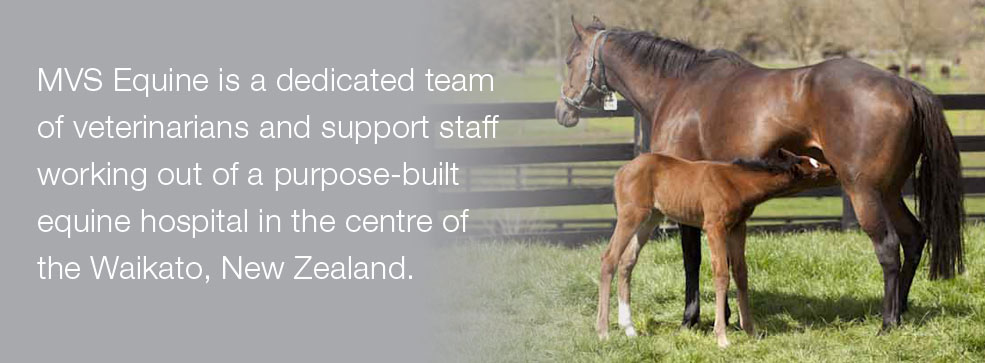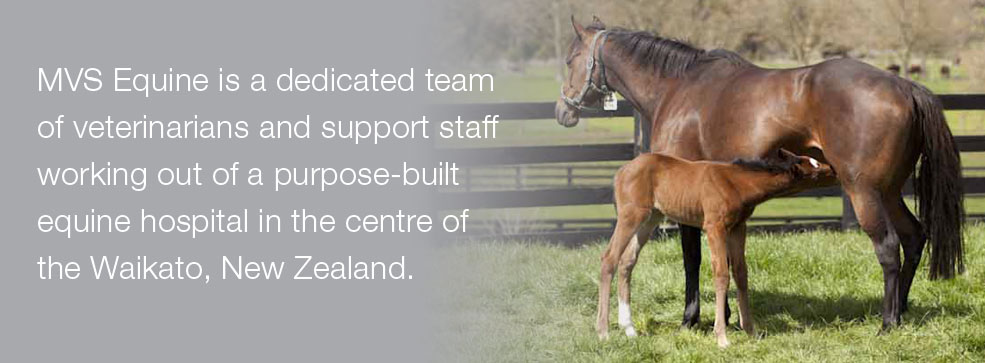Stem Cell Therapy
Stem Cell Therapy
October 9, 2015
Barbara Hunter DVM, MS, DACVS-LA
Specialist in Equine Surgery
What are Stem Cells?
Stem cells in adult mammals are cells that are still capable of acting like embryonic cells. They are known as pluripotent progenitor cells and they can develop into a multitude of different types of cells. The type of tissue they are surrounded by stimulates the type of cells they become. For example, if a stem cell is placed into a joint, it can be instructed by surrounding cartilage to develop into new cartilage cells. If placed into a tendon, stem cells can be stimulated to develop into new tendon cells or fibroblasts.
Stem cells can be found in many tissues, however the most commonly harvested tissues are bone marrow, adipose tissue or fat, and blood. Bone marrow yields by far the highest concentration of stem cells and stem cells harvested from bone marrow have also been shown to be more effective in developing into cartilage and tendon tissue than stem cells from other sources (Frisbie and Smith 2010). Several studies have compared bone marrow to adipose tissue for both the quantity of stem cells present following expansion and the ability of these cells to develop into bone, cartilage and tendon (Kisiday et al. 2008; Videl et al. 2008; Frisbie et al. 2009). Bone marrow has been proven superior both for quantity of stem cells yielded (bone marrow yields millions of cells vs adipose which yields several hundred thousand) and pluripotency (ability to develop into the type of end product cell desired). As a result, equine researchers consider bone marrow the preferred tissue to harvest stem cells from in adult horses for treatment of musculoskeletal injury.
When bone marrow stem cells were first tried clinically, bone marrow was harvested and injected directly into tendon lesions without any processing. Success was limited with this early technique, most likely due to the limited number of stem cells in unprocessed bone marrow (around 2000 stem cells/ml of bone marrow) (Frisbie and Smith 2010). Using cell expansion techniques, the stem cells within the bone marrow can be multiplied to several million cells. Injection of this increased number of cells, along with the growth factors that naturally accompany them, into injured tissues has resulted in better healing of tissues that have previously been prone to healing slowly with substandard scar tissue.
Where can stem cells be used?
- Meniscal Lesions (Stifle injuries)
- Tendon/Ligament injuries
- Degenerative Osteoarthritis (OA)
- OA secondary to Osteochondrosis (OCD)
Clinical success using bone marrow derived stem cells in horses
Multi-center clinical research studies in the USA have shown significant success in return to function following treatment of both soft tissue and orthopedic injuries with bone marrow derived stem cells. One study showed that 70% of orthopedic (joint and collateral ligament) injuries and 86% of soft tissue injuries (suspensory ligament, superficial digital flexor tendon, deep digital flexor tendon) were still in some level of work when follow up information was collected nearly 2 years following injection of bone marrow derived stem cells (Ferris et al. 2009). Another study found that 75% of horses with stifle meniscal injury were in some level of work 2 years following surgical debridement and intra-articular injection with bone marrow derived stem cells (Ferris et al. 2014). Forty-three percent of these horses returned to their previous level of work and 33% returned to a lower level of work. This is a substantial improvement over previous studies that have reported 60-65% of horses returning to some level of work following surgical debridement alone (Walmsley JP. 2003; Cohen et al. 2009). What makes the Ferris et al (2014) study even more outstanding is that several of the meniscal injuries were Grade 3 meniscal tears (meniscal tears are graded as 1, 2, or 3 with 3 being a severe tear of the front half of the meniscus) while most of the tears treated in earlier studies were Grade 1 or 2. In the study by Walmsley JP (2003), only 6% of horses with Grade 3 meniscal tears returned to work following treatment, while 25% of horses with Grade 3 tears in the Ferris et al (2014) study returned to their previous level of work and another 38% returned to a lower level of work. The substantial improvement in success that we see with injecting bone marrow derived stem cells following surgical debridement of menisci has many in the veterinary community excited. Injuries that were previously career ending, potentially even life threatening if severe enough, now seem to be treatable if treated before secondary osteoarthritis can set in.
What is the process for treating your horse with stem cells?
The stem cells we use are autologous bone marrow derived stem cells, meaning they are harvested from the bone marrow of your horse. Most commonly we use a small volume (10-15 mls) of bone marrow aspirated from the sternum. The bone marrow is acquired during a standing procedure that can be done on an outpatient basis.
Following acquisition of the bone marrow, it is processed in the ART New Zealand stem cell lab. This lab uses bone marrow stem cell expansion techniques that have been validated and used clinically by ART USA for several years. Their technique produces stem cells that have been proven clinically to improve healing of musculoskeletal injury (Ferris et al. 2014; Ferris et al. 2009). Cell expansion generally takes 3-4 weeks depending on the age of the horse (cells from older horses expand more slowly).
Following expansion of the stem cells, they are frozen and returned to our clinic for injection. A small number of stem cells can be stored at the lab for re-expansion and use in future treatments.
On arrival back at our clinic, the cells are thawed and injected into your horse’s injured tissue. If this is a tendon, this is done under ultrasound guidance and cells are placed directly into the tendon lesion. In cases where tendon lesions are not accessible (eg: deep digital flexor tendon lesions within the hoof capsule that have been diagnosed with CT, stem cells can be injected via intra-arterial regional limb perfusion. Studies have shown that following infusion of stem cells into the median artery of the forelimb, cells are distributed to the lower limb, including the injured tissue (Sole et al. 2013; Trela et al. 2014). All injections are done under sterile conditions, and horses are treated with broad-spectrum systemic antibiotics at the time of injection.
If you have any questions regarding the use of stem cell treatment in your horse, please call and speak to one of our experts. You may also see http://art4dvm.com for further information on bone marrow derived stem cells.
References:
Frisbie, D.D., and Smith, R.K.W. (2010) Clinical update on the use of mesenchymal stem cells in equine orthopedics. Eq. Vet. J. 42:86-89.
Kisiday, J.D., Kopesky, P.W., Evans, C.H., Grodzinsky, A.J., McIlwraith, C.W. and Frisbie, D.D. (2008) Evaluation of adult equine bone marrow and adipose derived progenitor cell chondrogenesis in hydrogel cultures. J. Orthop. Res. 26:322-331.
Vidal, M.A., Robinson, S.O., Lopez, M.J., Paulsen, D.B., Borkhsenious, O., Johnson, J.R., Moore, R.M. and Gimble, J.M. (2008) Comparison of chondrogenic potential in equine mesenchymal stromal cells derived from adipose tissue and bone marrow. Vet. Surg. 37:713-724.
Frisbie, D.D., Kisiday, J.D., Kawcak, C.E.,Werpy, N.M. and McIlwraith, C.W. (2009) Evaluation of adipose-derived stromal vascular fraction or bone marrow-derived mesenchymal stem cells for treatment of osteoarthritis. J. Orthop. Res. DOI 10.1002/jor.20933.
Ferris, D.J., Kisiday, J.D., McIlwraithe, C.W., et al. (2009) Clinical follow up of horses treated with bone marrow-derived mesenchymal stem cells for musculoskeletal lesions. Proc. Am. Assoc. Eq. Pract. Ann. Conv. 55:59-60.
Ferris, D.J., Frisbie, D.D., Kisiday, J.D., et al. (2014) Clinical outcome after intra-articular administration of bone marrow derived mesenchymal stem cells in 33 horses with stifle injury. Vet. Surg. 43:255-265.
Walmsley, J.P. (2003) Meniscal tears in horses: an evaluation of clinical signs and arthroscopic treatment of 80 cases. Eq. Vet. J. 35:402–406.
Cohen, J.M., Richardson, D.W., McKnight, A.L., et al. (2009) Long‐term outcome in 44 horses with stifle lameness after arthroscopic exploration and debridement. Vet. Surg. 38:543–551.
Sole, A., Spriet, M., Padgett, K. A. et al. (2013) Distribution and persistence of technetium-99 hexamethyl propylene amine oxime-labelled bone marrow-derived mesenchymal stem cells in experimentally induced tendon lesions after intratendinous injection and regional perfusion of the equine distal limb. Eq. Vet. J. 45:726-731.
Trela, J.M., Spriet, M., Padgett, K. A. et al. (2014) Scintigraphic comparison of intra-arterial injection and distal intravenous regional limb perfusion for administration of mesenchymal stem cells to the equine foot. Eq. Vet. J. 46:479-483.




